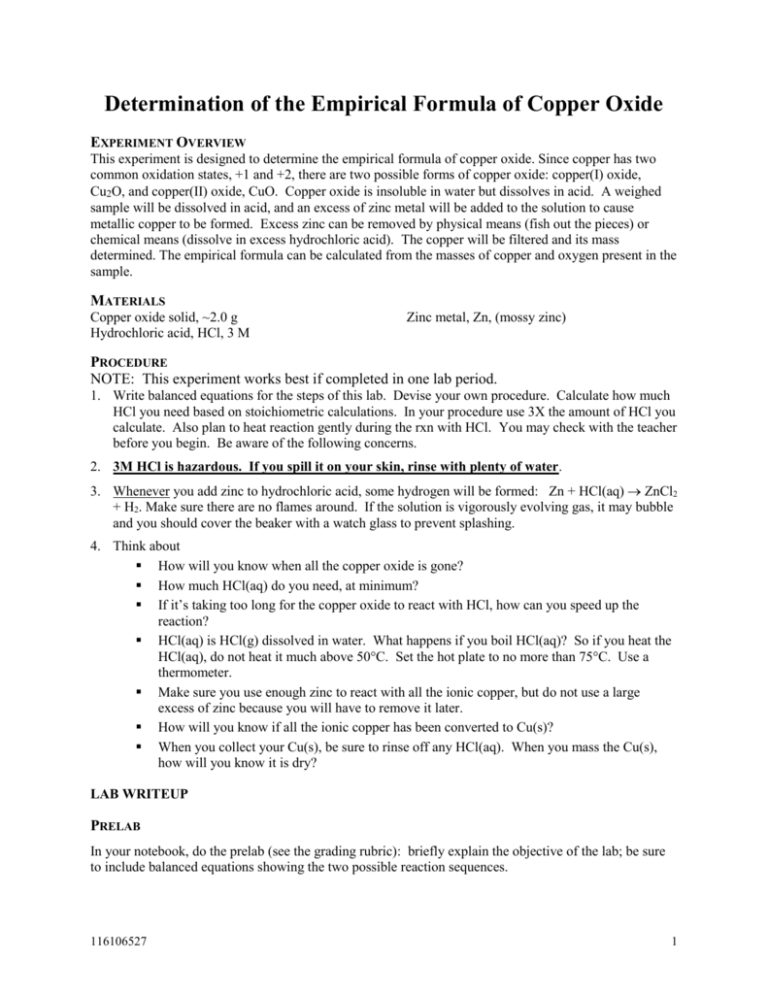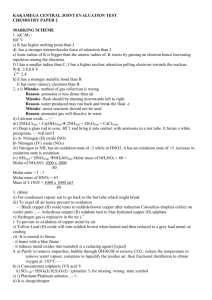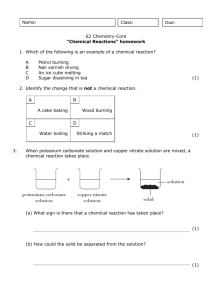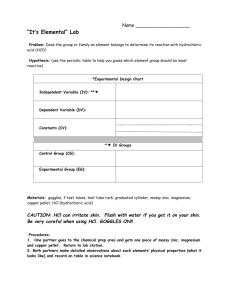Determination of the Empirical Formula of Copper Oxide
advertisement

Determination of the Empirical Formula of Copper Oxide EXPERIMENT OVERVIEW This experiment is designed to determine the empirical formula of copper oxide. Since copper has two common oxidation states, +1 and +2, there are two possible forms of copper oxide: copper(I) oxide, Cu2O, and copper(II) oxide, CuO. Copper oxide is insoluble in water but dissolves in acid. A weighed sample will be dissolved in acid, and an excess of zinc metal will be added to the solution to cause metallic copper to be formed. Excess zinc can be removed by physical means (fish out the pieces) or chemical means (dissolve in excess hydrochloric acid). The copper will be filtered and its mass determined. The empirical formula can be calculated from the masses of copper and oxygen present in the sample. MATERIALS Copper oxide solid, ~2.0 g Hydrochloric acid, HCl, 3 M Zinc metal, Zn, (mossy zinc) PROCEDURE NOTE: This experiment works best if completed in one lab period. 1. Write balanced equations for the steps of this lab. Devise your own procedure. Calculate how much HCl you need based on stoichiometric calculations. In your procedure use 3X the amount of HCl you calculate. Also plan to heat reaction gently during the rxn with HCl. You may check with the teacher before you begin. Be aware of the following concerns. 2. 3M HCl is hazardous. If you spill it on your skin, rinse with plenty of water. 3. Whenever you add zinc to hydrochloric acid, some hydrogen will be formed: Zn + HCl(aq) ZnCl2 + H2. Make sure there are no flames around. If the solution is vigorously evolving gas, it may bubble and you should cover the beaker with a watch glass to prevent splashing. 4. Think about How will you know when all the copper oxide is gone? How much HCl(aq) do you need, at minimum? If it’s taking too long for the copper oxide to react with HCl, how can you speed up the reaction? HCl(aq) is HCl(g) dissolved in water. What happens if you boil HCl(aq)? So if you heat the HCl(aq), do not heat it much above 50°C. Set the hot plate to no more than 75°C. Use a thermometer. Make sure you use enough zinc to react with all the ionic copper, but do not use a large excess of zinc because you will have to remove it later. How will you know if all the ionic copper has been converted to Cu(s)? When you collect your Cu(s), be sure to rinse off any HCl(aq). When you mass the Cu(s), how will you know it is dry? LAB WRITEUP PRELAB In your notebook, do the prelab (see the grading rubric): briefly explain the objective of the lab; be sure to include balanced equations showing the two possible reaction sequences. 116106527 1 PROCEDURE Describe your procedure so that a trained chemist could reproduce your results (but more detail is always better). Write your procedure in the PAST tense and in first or second person. DATA as required OBSERVATIONS as required – make sure you note colors. NOTE: Clear is not a color; instead use the term colorless. CALCULATIONS Calculate the weight percent copper in copper oxide that you observed. Determine the empirical formula of the copper oxide you started with. Calculate the % error in your % copper in copper oxide. DISCUSSION What is the result of your experiment—did you start with Cu(I) oxide or Cu(II) oxide? If you had >5% error in your %Cu, what could have caused your error and how could you prevent this error? 116106527 2









